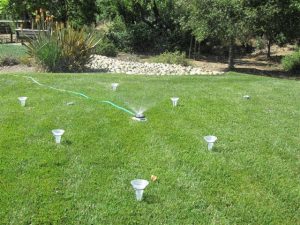As a Master Gardener, I’m often asked to look at yards with faltering or dying plants and trees. The number one cause of plant death is said to be over watering, but that is not always the case. Here are the most frequent problems I have encountered.
Native Oak Trees: This is one example of when over watering can indeed be fatal. For centuries, our oaks have grown and thrived with wet winters and dry summers. Winter cold and dry summer heat prevent fungus diseases from attacking the trees’ roots, but damp summer soil sets the stage for potentially devastating fungal growth.
In our dry, sizzling summers, many have turned to drip irrigation or soaker hoses to cut down on water. Dripped plants and trees can truly thrive while conserving greatly on water. However, all watering systems need regular monitoring.
Drip Irrigation:
- Routinely check to assure that sprinkler heads and emitters are doing their job. Sediment, soil, and insects often plug up the works, or emitters become inappropriately moved. Many systems have end caps that can be removed for flushing. Filters, pressure controls, and clips to hold emitters in place are a great help.
- Timers—a wonderful innovation for those of us who don’t wish to be watering slaves. Some timers can be adjusted for anywhere from multiple waterings weekly to every two or three weeks for drought tolerant plantings. Each season, adjust the length and frequency of watering, as needs fluctuate greatly with temperature, time of year, and sun patterns. Of course, new plants must be watered more often than established ones. Don’t forget to turn off your timers during the rainy season or your plants may succumb to over watering.
- Put water in the right spot—in your plants’ root systems. Drip emitters should be placed away from a plant’s crown (the area where the roots join the stem or trunk) and at a tree’s drip line. Move the emitters out as the tree grows. Larger shrubs and trees may require several emitters to do the job! Replace or adjust sprinkler heads so you water only the planted areas. Urban drool (that’s water running down streets and parking lots) is not cool.
- Provide enough water. A damp soil surface doesn’t always mean watered roots. This is a frequent problem in our dry hills, for dehydrated soil resists absorbing water. Use a spade or trowel to dig down a few inches (six to eight inches for lawn and small plants, up to two feet for trees). If water is not penetrating, you may need to water more slowly or water for a shorter time to allow the water to seep in. Repeat until soil is thoroughly moist (this is called “cycling”). An alternate approach is to make a basin around a tree’s drip line and flood with water. Repeat if needed. Water again only when the soil begins to dry out.
LAWNS: Many savvy gardeners are converting lawns to native,
drought tolerant landscaping. Even so, a soothing swath of green can be most welcome in summer heat. To cut water usage:
- Water only in the morning so the moisture penetrates before heat sets in. This also prevents grass and adjacent plants from sitting wet overnight—a fungal disease risk. Be sure the entire root zone is watered (see preceding comments about irrigation cycling). Aeration will also help your lawn absorb moisture.
- Identify over- and under-watered areas by placing straight-sided cans (tuna and cat food cans work well) on your lawn and compare the water levels after sprinkling. Clean or replace sluggish heads.
- Rewater only when footprints show in the grass when walked on. Grass may need twice as much water in summer heat so adjust water schedule accordingly and reduce scheduling in the cooler fall.
By fine-tuning watering, you can save time and money, and have a better-looking landscape as well. Now that’s a good deal!
Due to drought conditions, TUD has instituted Phase III water conservation measures. A mandatory water reduction of 30% has been set for all customers based upon their water usage of 2013. Here is Tuolumne Utility District’s website address; ww.tudwater.com for more water conservation information.
Vera Strader is a University of California Cooperative Extension Master Gardener of Tuolumne County.


